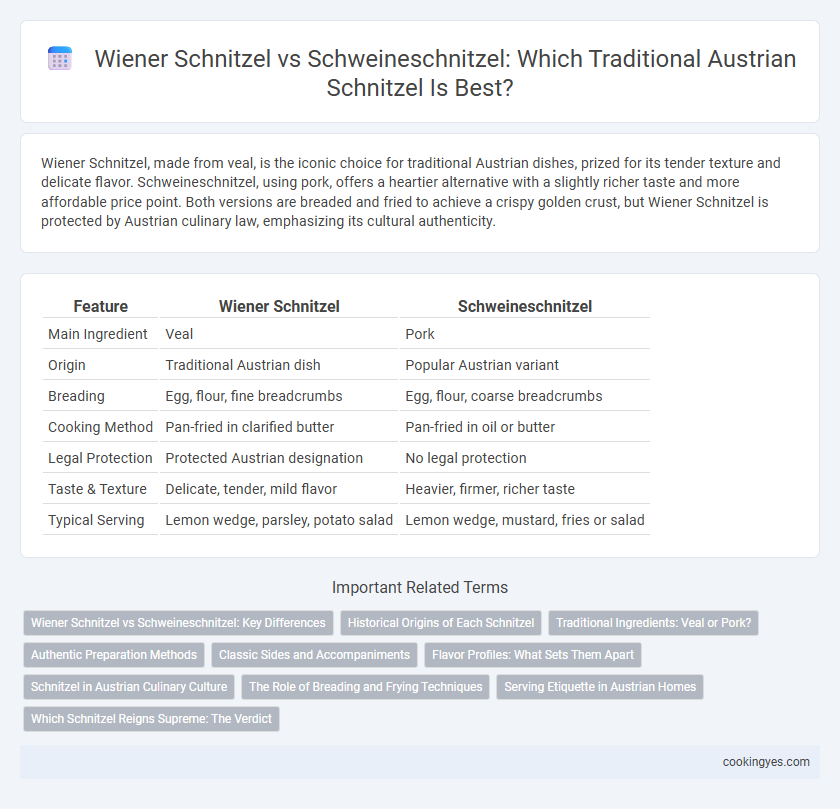Wiener Schnitzel, made from veal, is the iconic choice for traditional Austrian dishes, prized for its tender texture and delicate flavor. Schweineschnitzel, using pork, offers a heartier alternative with a slightly richer taste and more affordable price point. Both versions are breaded and fried to achieve a crispy golden crust, but Wiener Schnitzel is protected by Austrian culinary law, emphasizing its cultural authenticity.
Table of Comparison
| Feature | Wiener Schnitzel | Schweineschnitzel |
|---|---|---|
| Main Ingredient | Veal | Pork |
| Origin | Traditional Austrian dish | Popular Austrian variant |
| Breading | Egg, flour, fine breadcrumbs | Egg, flour, coarse breadcrumbs |
| Cooking Method | Pan-fried in clarified butter | Pan-fried in oil or butter |
| Legal Protection | Protected Austrian designation | No legal protection |
| Taste & Texture | Delicate, tender, mild flavor | Heavier, firmer, richer taste |
| Typical Serving | Lemon wedge, parsley, potato salad | Lemon wedge, mustard, fries or salad |
Wiener Schnitzel vs Schweineschnitzel: Key Differences
Wiener Schnitzel is a traditional Austrian dish made exclusively from veal, characterized by its thin, breaded, and fried cutlet, which ensures a tender and delicate flavor. Schweineschnitzel, on the other hand, uses pork and tends to be thicker and meatier, offering a heartier taste that is less subtle than veal. The key differences lie in the meat type, texture, and flavor profile, with Wiener Schnitzel being a protected regional specialty under Austrian culinary law.
Historical Origins of Each Schnitzel
Wiener Schnitzel, a celebrated dish in Austrian cuisine, traces its origins to 19th-century Vienna, where it was originally made exclusively from veal, emphasizing premium quality and culinary tradition. Schweineschnitzel, a variant using pork, emerged later as a more affordable alternative, gaining popularity post-World War II due to its accessibility and adaptability in everyday Austrian kitchens. Both schnitzels reflect Austria's rich culinary heritage but differ historically in meat choice and social context.
Traditional Ingredients: Veal or Pork?
Wiener Schnitzel is traditionally made from veal, a tender and delicate meat that defines the authentic Austrian dish. Schweineschnitzel, on the other hand, uses pork, which is more affordable and widely consumed in Austria but considered less classic. The choice between veal and pork impacts the flavor, texture, and cultural authenticity of these iconic schnitzel varieties.
Authentic Preparation Methods
Wiener Schnitzel, traditionally made from veal, is breaded using a three-step process of flour, egg wash, and fine breadcrumbs, then fried in clarified butter or lard to achieve a crisp, golden crust without excessive oil absorption. Schweineschnitzel, made from pork, follows a similar breading technique but often incorporates marination in garlic or lemon juice for enhanced flavor, reflecting regional variations within Austria. Both dishes emphasize thin, tender meat pounded evenly to ensure quick, even cooking, critical to authentic preparation methods that preserve the classic texture and taste of Austrian cuisine.
Classic Sides and Accompaniments
Wiener Schnitzel, traditionally made from veal, is often served with classic Austrian sides such as potato salad, lingonberry jam, and a slice of lemon to enhance its delicate flavor. Schweineschnitzel, usually made from pork, pairs well with heartier accompaniments like cucumber salad, parsley potatoes, or creamy mushroom sauce, reflecting its richer taste profile. Both variations highlight the importance of simple, fresh ingredients that complement the crispy, breaded exterior central to authentic Austrian cuisine.
Flavor Profiles: What Sets Them Apart
Wiener Schnitzel features tender veal coated in a light, crispy breadcrumb crust, offering a delicate and subtle flavor profile cherished in traditional Austrian cuisine. Schweineschnitzel, made from pork, presents a heartier, more robust taste with slightly richer and juicier meat, appealing to those who prefer stronger flavors. The key distinction lies in the veal's mildness versus the pork's pronounced savoriness, making each schnitzel unique in texture and taste within Austria's culinary heritage.
Schnitzel in Austrian Culinary Culture
Wiener Schnitzel, a classic Austrian dish, is traditionally made from veal and holds protected designation under Austrian law, symbolizing authentic Viennese culinary heritage. Schweineschnitzel, made from pork, is a popular regional variation that offers a more affordable and widely consumed alternative while maintaining the crispy, breaded texture integral to Schnitzel. Both types are fundamental to Austrian culinary culture, exemplifying the country's emphasis on tender meat, golden breadcrumbs, and a balance of simplicity and flavor.
The Role of Breading and Frying Techniques
Wiener Schnitzel, traditionally made from veal, distinguishes itself through a delicate breading process using fine breadcrumbs, creating a light, crispy crust essential to authentic Austrian cuisine. In contrast, Schweineschnitzel employs thicker breading and a slightly longer frying time to complement pork's richer flavor, resulting in a heartier texture. Mastery of breading consistency and precise frying temperature ensures both variations achieve the ideal balance of moisture retention and golden crust characteristic of traditional dishes.
Serving Etiquette in Austrian Homes
Wiener Schnitzel, traditionally made from veal, is considered the national dish of Austria and is typically served with a slice of lemon, parsley potatoes, or lingonberry jam in Austrian homes, reflecting its cultural importance. Schweineschnitzel, using pork, is a popular everyday alternative often accompanied by potato salad or cucumber salad, highlighting its more casual status in serving etiquette. In formal Austrian meals, Wiener Schnitzel is presented with careful garnishing and precise portioning, whereas Schweineschnitzel is generally served in a more rustic style, emphasizing comfort and simplicity.
Which Schnitzel Reigns Supreme: The Verdict
Wiener Schnitzel, made exclusively from veal, holds the title as the authentic and traditional Austrian delicacy, renowned for its delicate flavor and crispy golden breading. Schweineschnitzel, crafted from pork, offers a heartier, more affordable alternative that remains widely popular across Austria, often seasoned to enhance its robust taste. While Wiener Schnitzel reigns supreme in culinary prestige and cultural heritage, Schweineschnitzel dominates in everyday dining, making both essential staples in Austria's gastronomic landscape.
Wiener Schnitzel vs Schweineschnitzel for traditional Austrian dishes Infographic

 cookingyes.com
cookingyes.com